
Facts and statistics about Ajanta Ellora Caves are worth your time. Having a history that narrates the uniqueness of its existence sounds indeed worth mentioning!
This article will take you through all the facts and statistics about Ajanta Ellora caves…
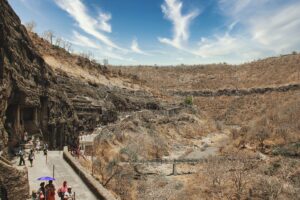
What are Ajanta Ellora Caves?
Ajanta Ellora Caves stand for magnificent rock-cut caves.
Ajanta caves and Ellora caves occur next to each other. Both of them stand firm singe ages.
A fascinating fact is that it’s on a horseshoe-shaped rock.
Carved out of granite found in Wagora river valley. Also, the best cave monuments are known in India.
Location
Heartily located in the state of Maharashtra. The caves situate themselves near Ajanta village.
Ajanta Ellora Caves fall at 100 km northeast of Aurangabad and 455 km northeast of Mumbai.
It also has suitable visiting hours.
Opens at 9:00 am and closes at 5:00 pm sharp! And also closed on Mondays.
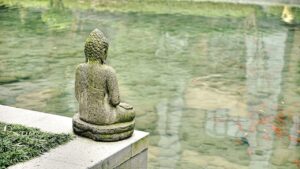
Who made Ajanta Ellora Caves?
The credit goes to the Buddha’s!
The facts state that the constructors of Ajanta Ellora Caves were Buddhist monks.
The caves were highly used by the monks for refugee purposes.
So, you might be thinking, ‘refugee? From what?’ They had to take refugees from bad weather. Buddhists are travelers. As travelers, they hated monsoons and thus took refuge in the Ajanta Ellora caves.
Who discovered them?
Discoveries take place due to two reasons. Firstly, with an intention of discovering, and secondly, they simply happen.
According to the facts in hand, the discovery of Ajanta Ellora Caves was accidental.
Captain John Smith headed with his hunting party discovered the caves accidentally in 1819.
This led to the entry of several excavators to this land.
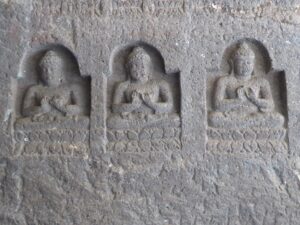
How old are they?
According to the facts and statistics we gathered, Ajanta Ellora Caves are among the oldest!
They have had a fruitful existence ever since the 2nd century BC.
Which means 2000 years old!
A UNESCO accepted site…
Listed as the oldest UNESCO-identified World Heritage Site since 1983.
Also listed under the ‘protected monument’ category by the Archaeological Survey of India.
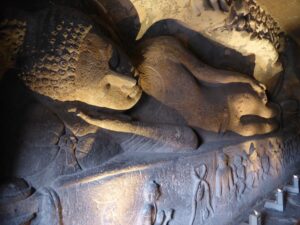
Is it possible to cover the caves in one day?
Sightseeing is not only about visiting and watching. It’s about being there and basking in what it offers.
Looking at the number of things it has to offer, one-day exploration is a big NO!
What is it famous for?
Ajanta Ellora Caves, of course, are famous for their caves. But the precious paintings that lie inside of it climb the list of popularity too.
Nevertheless, sculptures are important as well.
Caves present in Ajanta
According to the data, Ajanta caves are a cluster of 29 rock-cut caves.
They beautifully present Buddhist architecture in its truest form. Similarly, they also include picturesque sculptures and striking paintings!
Buddhist monks were the ones to build the entire cave with their own hands. As stated in the data they used simple tools, for example, a hammer.
Cave 4 is the largest cave among all.
The first likely excavated cave was cave 10.
Cave 16 has a staircase that holds importance as an original ‘entrance stairway’.
The most stunning cave throughout Ajanta is cave 26. It has numerous paintings and beautiful carvings that glow its glory.
One cannot forget to mention the Kailasha temple! A Hindu temple of the deity Shiva holds the status of largest rock-cut in Ellora Caves.
Kailasha temple dates back to the 8th century, hence considered the most remarkable cave temple in the entire WORLD!

Sculptures!
A number of sculptures carved in here narrate their stories to their visitors.
Did you know that carving has a particular theme?
Indeed they follow a theme. The carving inside illustrates stories and events that relate to Buddhist lives.
They also narrate the famous Jataka Tales.
A few of them also portray their teachings and philosophy as well.
But Buddhism says not to present itself in sculptures or any other form. It has a strict principle of freeing oneself from objects. So, why do we find sculptures and paintings? The fact is unknown!
Carvings
Carvings begin with ceilings.
Beyond the ceilings, carvings mark their presence on pillars as well.
Detailed carvings with a breath-taking beauty like no other.
The craving includes- princesses, dancers, elephants, Bullfights, lovers, etc.
The paintings!
According to facts and statistics, Ajanta Ellora Caves store one of the finest paintings. Also the earliest surviving among all.
The wall painting found, trace their existence back to the ancient world. Known for their glory during the Gupta dynasty.
Hence very well known for their wall paintings!
Paintings hold a key position in the caves…
The painting found holds a strong trace to that of Tibet and also Sri Lanka.
The facts state that during their refuge, Buddhists decorated the caves. These decorations now exist in the form of paintings and sculptures.
They mark the commencement of Indian classical art through the hands of monks.
Also, the material used in the binding of the painting is glue.
Along with other paintings, murals also hold their heads high in the caves. These murals attract the majority of its connoisseurs. Also, it contributes to world art as a mark of ancient Indian art.
Out of 29 caves, only 16 have a record of withholding paintings in them. The caves that have the paintings are 1, 2, 9, 10, 16, and 17.
Cave 1 has the best-preserved paintings.
Painting in cave 2 depicts the birth of Buddha. It’s a scene from Vidurapandita Jataka.
The paintings graciously reflect human gestures. For example, the expressive gesture of hands while dancing.
The painting occurs on the pillars, walls, and on ceilings as well.
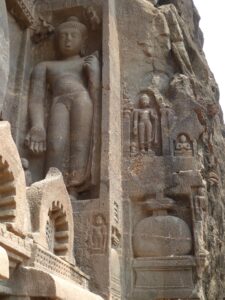
Let us dive into history a bit…
The entire cave’s origin distributes itself into two.
1st phase of construction and 2nd phase of construction.
Firstly, the 1st phase of construction shaped Chaitaniya Grihas. Precisely sculpted on the valley of the Waghora River.
Secondly, the 2nd phase of construction saw the building of temples. A total of 20 temples came into the picture.

Conclusion
The caves of Ajanta and Ellora stand to show the world its richness. The facts and statistics about Ajanta Ellora Caves show the historical, cultural, and artistic standards of its times.
A beauty drenched in the form of architecture shows us how beautiful-minded our ancestors were. Now, don’t you think it is worth admiring this beauty?



